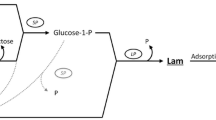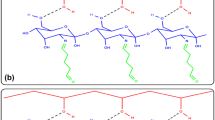Abstract
An approach to stable covalent immobilization of chemically modified penicillin G acylase from Escherichia coli on Sepabeads® carriers with high retention of hydrolytic activity and thermal stability is presented. The two amino-activated polymethacrylate particulate polymers with different spacer lengths used in the study were Sepabeads® EC EA and Sepabeads® EC HA. The enzyme was first modified by cross-linking with polyaldehyde derivatives of starch in order to provide it with new useful functions. Such modified enzyme was then covalently immobilized on amino supports. The method seems to provide a possibility to couple the enzyme without risking a reaction at the active site which might cause the loss of activity. Performances of these immobilized biocatalysts were compared with those obtained by the conventional method with respect to activity and thermal stability. The thermal stability study shows that starch-PGA immobilized on Sepabeads EC-EA was almost 4.5-fold more stable than the conventionally immobilized one and 7-fold more stable than free non-modified PGA. Similarly, starch-PGA immobilized on Sepabeads EC-HA was around 1.5- fold more stable than the conventionally immobilized one and almost 9.5-fold more stable than free non-modified enzyme.
Similar content being viewed by others
References
Al-Duri, B., & Yong, Y. P. (2000). Lipase immobilisation: an equilibrium study of lipases immobilised on hydrophobic and hydrophilic/hydrophobic supports. Biochemical Engineering Journal, 4, 207–215. DOI: 10.1016/S1369-703X(99)00050-9.
Alvaro, G., Blanco, R. M., Fernandez-Lafuente, R., & Guisan, J. M. (1990). Immobilization-stabilization of penicillin G acylase from E. coli. Applied Biochemistry and Biotechnology, 26, 181–195. DOI: 10.1007/BF02921533.
Betancor, L., López-Gallego, F., Hidalgo, A., Alonso-Morales, N., Dellamora-Ortiz, G., Mateo, C., Fernández-Lafuente, R., & Guisán, J. M. (2006). Different mechanisms of protein immobilization on glutaraldehyde activated supports: effect of support activation and immobilization conditions. Enzyme and Microbial Technology, 39, 877–882. DOI: 10.1016/j.enzmictec.2006.01.014.
Blanco, R. M., Calvete, J. J., & Guisán, J. M. (1989). Immobilization-stabilization of enzymes; variables that control the intensity of the trypsin (amine)-agarose (aldehyde) multipoint covalent attachment. Enzyme and Microbial Technology, 11, 353–359. DOI: 10.1016/0141-0229(89)90019-7.
Cardias, H. C. T., Grininger, C. C., Trevisan, H. C., Guisan, J. M., & Giordano, R. L. C. (1999). Influence of activation on the multipoint immobilization of penicillin G acylase on macroporous silica. Brazilian Journal of Chemical Engineering, 16, 141–148.
DuBois, M., Gilles, K. A., Hamilton, J. K., Rebers, P. A., & Smith, F. (1956). Colorimetric method for determination of sugars and related substances. Analytical Chemistry, 28, 350–356. DOI: 10.1021/ac60111a017.
Eldin, M. S. M., Schroën, C. G. P. H., Janssen, A. E. M., Mita, D. G., & Tramper, J. (2000). Immobilization of penicillin G acylase onto chemically grafted nylon particles. Journal of the Molecular Catalysis B: Enzymatic, 10, 445–451. DOI: 10.1016/S1381-1177(99)00122-8.
Fernández-Lafuente, R., Rosell, C. M., Alvaro, G., & Guisán, J. M. (1992). Additional stabilization of penicillin G acylaseagarose derivatives by controlled chemical modification with formaldehyde. Enzyme and Microbial Technology, 14, 489–495. DOI: 10.1016/0141-0229(92)90143-C.
Fernandez-Lafuente, R., Rosell, C. M., Caanan-Haden, L., Rodes, L., & Guisan, J. M. (1999). Facile synthesis of artificial enzyme nano-environments via solid-phase chemistry of immobilized derivatives: Dramatic stabilization of penicillin acylase versus organic solvents. Enzyme and Microbial Technology, 24, 96–103. DOI: 10.1016/S0141-0229(98)00102-1.
Guisán, J. M. (1988). Aldehyde-agarose gel as activated supports for immobilization-stabilization of enzymes. Enzyme and Microbial Technology, 10, 375–382. DOI: 10.1016/0141-0229(88)90018-X.
Guisán, J. M., Alvaro, G., Fernandez-Lafuente, R., Rosell, C. M., Garcia, J. L., & Tagliani, A. (1993). Stabilization of a heterodymeric enzyme by multi-point covalent immobilization: Penicillin G acylase from Kluyvera citrophila. Biotechnology and Bioengineering, 42, 455–464. DOI: 10.1002/bit.260420408.
Gupta, M. N. (1991). Thermostabilization of proteins. Biotechnology and Applied Biochemistry, 14, 1–11.
Illanes, A., Cabrera, Z., Wilson, L., & Aguirre, C. (2003). Synthesis of cephalexin in ethylene glycol with glyoxylagarose immobilised penicillin acylase: temperature and pH optimisation. Process Biochemistry, 39, 111–117. DOI: 10.1016/S0032-9592(03)00031-1.
Iyer, P. V., & Ananthanarayan, L. (2008). Enzyme stability and stabilization—Aqueous and non-aqueous environment. Process Biochemistry, 43, 1019–1032. DOI: 10.1016/j.procbio. 2008.06.004.
Kallenberg, A., van Rantwijk, F., & Sheldon, R. (2005). Immobilization of penicillin G acylase: the key to optimum performance. Advanced Synthesis and Catalysis, 347, 905–926. DOI: 10.1002/adsc.200505042.
Kazan, D., Ertan, H., & Erarslan, A. (1997). Stabilization of Escherichia coli penicillin G acylase against thermal inactivation by cross-linking with dextran dialdehyde polymers. Applied Microbiology and Biotechnology, 48, 191–197. DOI: 10.1007/s002530051037.
Klibanov, A. M. (1983). Approaches to enzyme stabilization. Biochemical Society Transactions, 11, 19–20.
Kobayashi, M., & Takatsu, K. (1994). Cross-linked stabilization of trypsin with dextran-dialdehyde. Bioscience, Biotechnology, and Biochemistry, 58, 275–278.
Knezevic, Z., Milosavic, N., Bezbradica, D., Jakovljevic, Z., & Prodanovic, R. (2006). Immobilization of lipase from Candida rugosa on Eupergit® C supports by covalent attachment. Biochemical Engineering Journal, 30, 269–278. DOI: 10.1016/j.bej.2006.05.009.
López-Gallego, F., Betancor, L., Mateo, C., Hidalgo, A., Alonso-Morales, N., Dellamora-Ortiz, G., Guisán, J. M., & Fernández-Lafuente, R. (2005). Enzyme stabilization by glutaraldehyde crosslinking of adsorbed proteins on aminated supports. Journal of Biotechnology, 119, 70–75. DOI: 10.1016/j.jbiotec.2005.05.021.
Lowry, O. H., Rosebrough, N. J., Farr, A. L., & Randall, R. J. (1951). Protein measurement with the folin phenol reagent. Journal of Biological Chemistry, 193, 265–275.
Martinek, K., Klibanov, A. M., Goldmacher, V. S., & Berezin, I. V. (1977). The principles of enzyme stabilization. I. Increase in thermostability of enzymes covalently bound to a complementary surface of a polymer support in a multipoint fashion. Biochimica et Biophysica Acta, 485, 1–12.
Mateo, C., Abian, O., Fernández-Lorente, G., Pedroche, J., Fernández-Lafuente, R., Guisan, J. M., Tam, A., & Daminati, M. (2002). Epoxy Sepabeads: A novel epoxy support for stabilization of industrial enzymes via very intense multipoint covalent attachment. Biotechnology Progress, 18, 629–634. DOI: 10.1021/bp010171n.
Mateo, C., Palomo, J.M., Fernandez-Lorente, G., Guisan, J.M., & Fernandez-Lafuente, R. (2007). Improvement of enzyme activity, stability and selectivity via immobilization techniques. Enzyme and Microbial Technology, 40, 1451–1463. DOI: 10.1016/j.enzmictec.2007.01.018.
Mislovicová, D., Masárová, J., Bucko, M., & Gemeiner, P. (2006). Stability of penicillin G acylase modified with various polysaccharides. Enzyme and Microbial Technology, 39, 579–585. DOI: 10.1016/j.enzmictec.2005.11.012.
Öztürk, D. C., Kazan, D., & Erarslan, I. (2002). Stabilization and functional properties of Escherichia coli penicillin G acylase with covalent conjugation of anionic polysaccharide carboxymethylcellulose. World Journal of Microbiology and Biotechnology, 18, 881–888. DOI: 10.1023/A:1021262826254.
Resindion SRL (2006). Mitsubishi Chemical Corporation: Products Line. Retrieved from http://www.resindion.com
Terreni, M., Ubiali, D., Bavaro, T., Pregnolato, M., Fernández-Lafuente, R., & Guisán, J. M. (2007). Enzymatic synthesis of cephalosporins. The immobilized acylase from Arthrobacter viscosus: A new useful biocatalysts. Applied Microbiology and Biotechnology, 77, 579–587. DOI: 10.1007/s00253-007-1186-3.
Torres-Guzmán, R., de la Mata, I., Torres-Bacete, J., Arroyo, M., Castillón, M. P., & Acebal, C. (2002). Substrate specificity of penicillin acylase from Streptomyces lavendulae. Biochemical and Biophysical Research Communications, 291, 593–597. DOI: 10.1006/bbrc.2002.6485.
van Langen, L. M., Janssen, M. H. A., Oosthoek, N. H. P., Pereira, S. R. M., Svedas, V. K., van Rantwijk, F., & Sheldon, R. A. (2002). Active site titration as a tool for the evaluation of immobilization procedures of penicillin acylase. Biotechnology and Bioengineering, 79, 224–228. DOI: 10.1002/bit.10280.
Villalonga, R., Villalonga, M. L., & Gómez, L. (2000). Preparation and functional properties of trypsin modified by carboxymethylcellulose. Journal of Molecular Catalysis B: Enzymatic, 10, 483–490. DOI: 10.1016/S1381-1177(00)00003-5.
Zuza, M. G., Šiler-Marinković, S. S., & Knezević, Z. D. (2007). Preparation and characterization of penicillin acylase immobilized on Sepabeads EC-EP carrier. Chemical Industry & Chemical Engineering Quarterly, 13, 205–210.
Author information
Authors and Affiliations
Corresponding author
Rights and permissions
About this article
Cite this article
Žuža, M., Milosavić, N. & Knežević-Jugović, Z. Immobilization of modified penicillin G acylase on Sepabeads carriers. Chem. Pap. 63, 117–124 (2009). https://doi.org/10.2478/s11696-009-0012-z
Received:
Revised:
Accepted:
Published:
Issue Date:
DOI: https://doi.org/10.2478/s11696-009-0012-z




